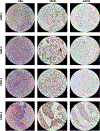TRPS1: a highly sensitive and specific marker for breast carcinoma, especially for triple-negative breast cancer
- PMID: 33011748
- PMCID: PMC12010768
- DOI: 10.1038/s41379-020-00692-8
TRPS1: a highly sensitive and specific marker for breast carcinoma, especially for triple-negative breast cancer
Abstract
Currently there is no highly specific and sensitive marker to identify breast cancer-the most common malignancy in women. Breast cancer can be categorized as estrogen receptor (ER)/progesterone receptor (PR)-positive luminal, human epidermal growth factor receptor 2 (HER2)-positive, or triple-negative breast cancer (TNBC) types based on the expression of ER, PR, and HER2. Although GATA3 is the most widely used tumor marker at present to determine the breast origin, which has been shown to be an excellent marker for ER-positive and low-grade breast cancer, but it does not work well for TNBC with sensitivity as low as <20% in metaplastic breast carcinoma. In the current study, through TCGA data mining we identified trichorhinophalangeal syndrome type 1 (TRPS1) as a specific gene for breast carcinoma across 31 solid tumor types. Moreover, high mRNA level of TRPS1 was found in all four subtypes of breast carcinoma including ER/PR-positive luminal A and B types, HER2-positive type, and basal-type/TNBC. We then analyzed TRPS1 expression in 479 cases of various types of breast cancer using immunochemistry staining, and found that TRPS1 and GATA3 had comparable positive expression in ER-positive (98% vs. 95%) and HER2-positive (87% vs. 88%) breast carcinomas. However, TRPS1 which was highly expressed in TNBC, was significantly higher than GATA3 expression in metaplastic (86% vs. 21%) and nonmetaplastic (86% vs. 51%) TNBC. In addition, TRPS1 expression was evaluated in 1234 cases of solid tumor from different organs. In contrast to the high expression of GATA3 in urothelial carcinoma, TRPS1 showed no or little expression in urothelial carcinomas or in other tumor types including lung adenocarcinoma, pancreatic adenocarcinoma, colon and gastric adenocarcinoma, renal cell carcinoma, melanoma, and ovarian carcinoma. These findings suggest that TRPS1 is a highly sensitive and specific marker for breast carcinoma and can be used as a great diagnostic tool, especially for TNBC.
Conflict of interest statement
Compliance with ethical standards
Figures







References
-
- Siegel RL, Miller KD, Jemal A. Cancer statistics, 2020. CA Cancer J Clin. 2020;70:7–30. - PubMed
-
- Goldhirsch A, Winer EP, Coates AS, Gelber RD, Piccart-Gebhart M, Thurlimann B, et al. Personalizing the treatment of women with early breast cancer: highlights of the St Gallen International Expert Consensus on the Primary Therapy of Early Breast Cancer 2013. Ann Oncol. 2013;24:2206–23. - PMC - PubMed
-
- Perou CM, Sorlie T, Eisen MB, van de Rijn M, Jeffrey SS, Rees CA, et al. Molecular portraits of human breast tumours. Nature. 2000;406:747–52. - PubMed
Publication types
MeSH terms
Substances
Grants and funding
LinkOut - more resources
Full Text Sources
Research Materials
Miscellaneous

